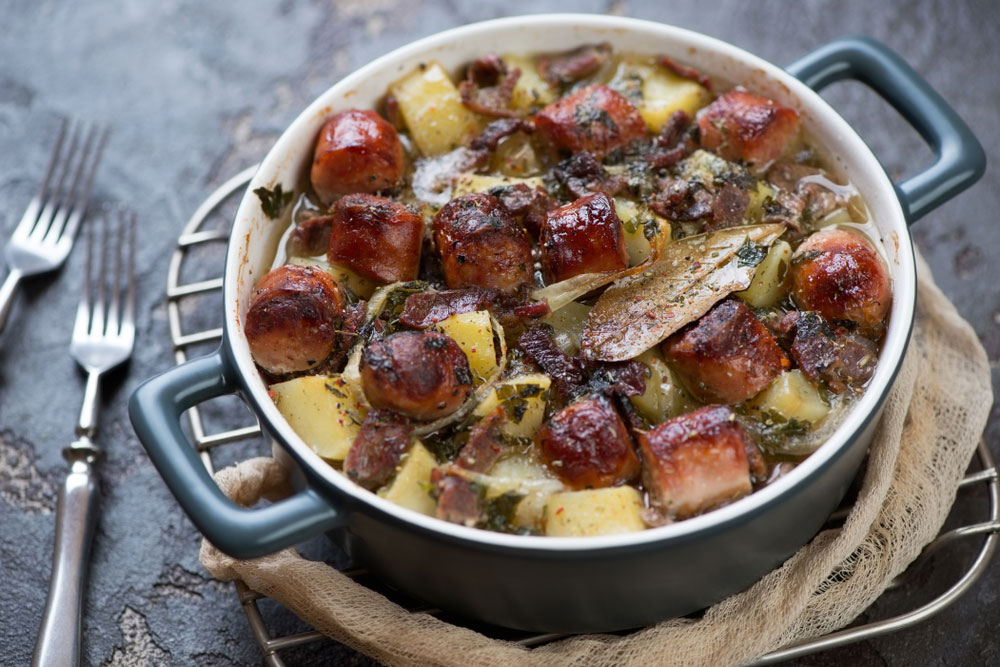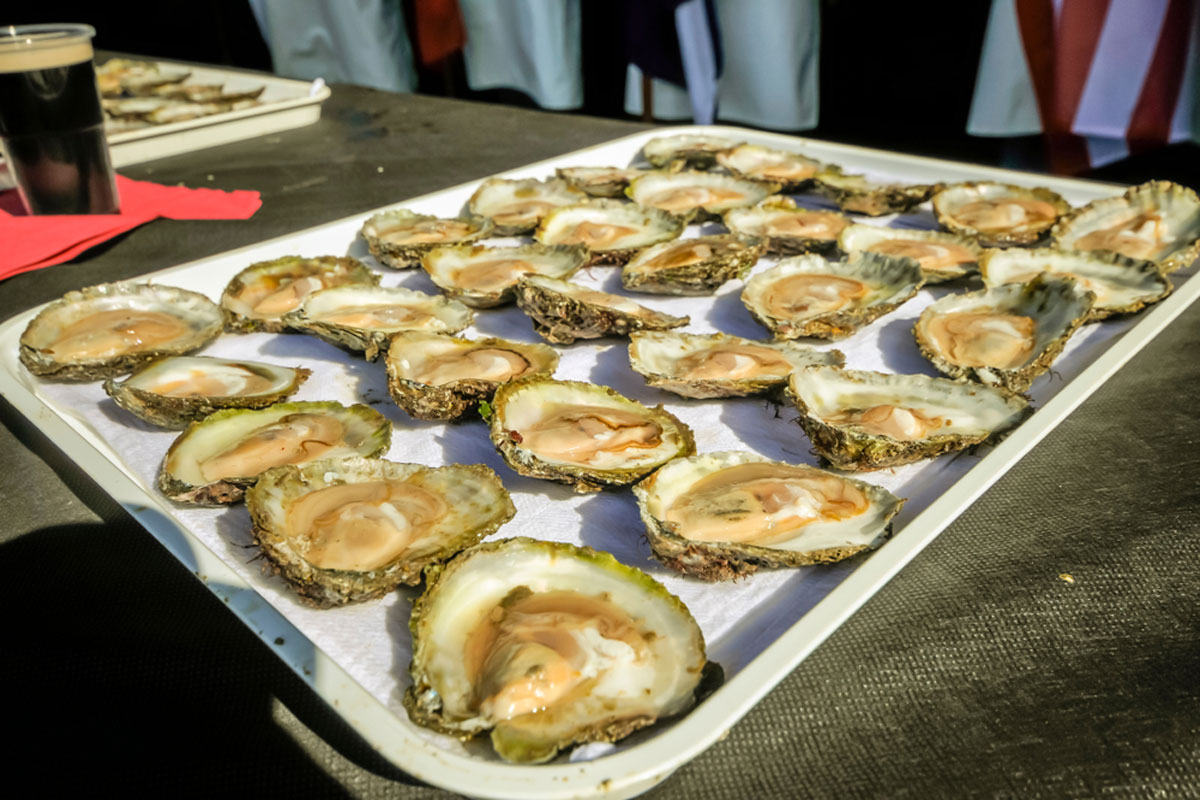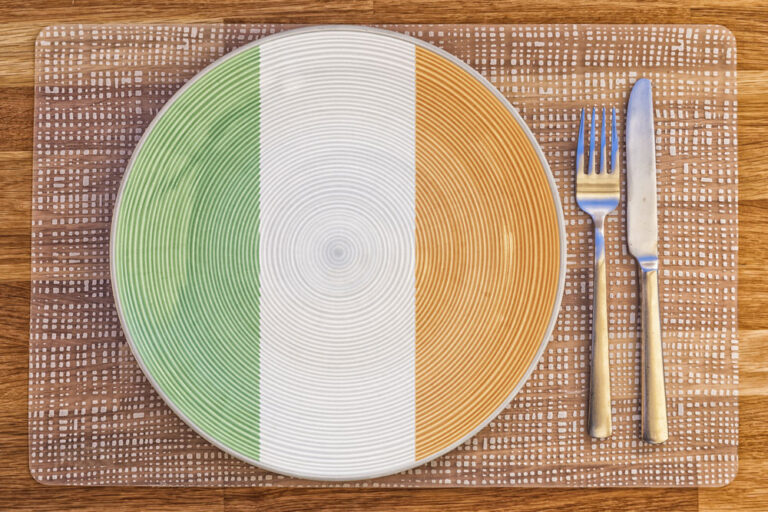Galway’s Famous Oysters
Ireland’s culinary landscape is as diverse and rich as its history and culture. Each region offers unique flavors and traditional dishes that reflect the local ingredients and customs. Let us now explore the regional specialties that make Ireland’s cuisine so distinctive, beginning with the famous oysters from Galway.
A Rich Tradition
Galway, a vibrant city on Ireland’s west coast, is renowned for its exceptional oysters. These oysters have been celebrated for centuries, with records of oyster harvesting in Galway Bay dating back to the early 19th century. The unique combination of the Atlantic’s salty waters and the freshwater from the River Corrib creates an ideal environment for oyster farming, resulting in some of the finest oysters in the world.
The Galway International Oyster and Seafood Festival
One of the most famous events in Galway is the annual Galway International Oyster and Seafood Festival, held every September. This festival, the oldest oyster festival in the world, attracts visitors from all over to indulge in the finest oysters and seafood while enjoying the lively atmosphere of music, parades, and culinary competitions. The highlight of the festival is the World Oyster Opening Championship, where contestants from around the globe compete to shuck oysters at lightning speed.
Culinary Experience
The oysters from Galway are best enjoyed fresh, straight from the shell, often with just a squeeze of lemon to enhance their natural briny flavor. For those looking to explore different preparations, local restaurants offer a variety of dishes that showcase these exquisite shellfish. From classic oysters on the half shell to innovative creations like oyster tempura or oysters Rockefeller, Galway’s culinary scene offers something for every palate.
Pairing with Irish Beverages
To fully appreciate the flavors of Galway oysters, they are often paired with a pint of Guinness or a glass of crisp, dry white wine. The creamy texture of Guinness complements the brininess of the oysters, creating a harmonious balance of flavors. Alternatively, a glass of Sauvignon Blanc or Champagne enhances the delicate sweetness of the oysters, making for an elegant and refreshing dining experience.
Sustainability and Preservation
Galway’s oyster farmers are committed to sustainable practices to ensure the longevity of their industry. By carefully managing the oyster beds and adhering to strict environmental regulations, they help preserve the delicate ecosystem of Galway Bay. This commitment to sustainability not only ensures the continued availability of these delectable oysters but also protects the natural beauty and biodiversity of the region.
Final Thoughts
Galway’s oysters are more than just a delicacy; they are a symbol of the region’s rich maritime heritage and culinary excellence. The combination of pristine waters, time-honored traditions, and sustainable practices results in oysters that are truly exceptional. Whether enjoyed fresh at the annual oyster festival or savored in a local restaurant, Galway’s oysters offer a unique and unforgettable taste of Ireland’s coastal bounty.
Waterford’s Renowned Blaa Bread
As we continue our culinary journey through Ireland, our next stop takes us to the southeast coast, where the city of Waterford offers a unique and beloved regional specialty: the blaa bread. This soft, floury bread roll has a rich history and a cherished place in the hearts (and stomachs) of locals.
A Storied Past
The blaa is believed to have been introduced to Waterford in the 17th century by French Huguenots who settled in the area. The name “blaa” is thought to derive from the French word “blanc,” meaning white, a reference to the bread’s characteristic flour-dusted appearance. Over the centuries, the blaa has become an integral part of Waterford’s culinary identity.
Protected Status
In 2013, the blaa was granted Protected Geographical Indication (PGI) status by the European Union, recognizing its cultural and historical significance and ensuring that only bread produced in Waterford can be officially called a blaa. This prestigious status places the blaa alongside other renowned European foods such as Champagne and Parma ham.
Culinary Uses
Blaa bread is incredibly versatile and can be enjoyed in various ways. Traditionally, it is served as a simple bread roll, perfect for breakfast or lunch. A typical Waterford breakfast might include a blaa filled with rashers (Irish bacon), sausages, and a fried egg. For lunch, the blaa can be used to create delicious sandwiches, filled with a variety of ingredients such as ham, cheese, and salad. The soft, slightly chewy texture of the blaa makes it an ideal vessel for both savory and sweet fillings.
The Art of Making Blaa
Making blaa bread is a labor of love that involves a few key steps. The dough is prepared using simple ingredients: flour, water, yeast, salt, and sugar. After the dough has risen, it is divided into individual portions and shaped into rolls. Each roll is generously dusted with flour before being allowed to rise again. Finally, the blaas are baked until they develop a light, fluffy interior and a soft, floury crust. (Our Blaa Recipe)
Cultural Significance
The blaa is more than just a bread roll; it is a symbol of Waterford’s heritage and community spirit. Local bakeries have passed down the tradition of making blaas through generations, ensuring that this beloved bread remains a staple in the daily lives of Waterford residents. The blaa’s enduring popularity is a testament to its timeless appeal and the pride that Waterford takes in its culinary traditions.
Final Thoughts
Waterford’s blaa bread is a shining example of how food can reflect the history and culture of a region. Its soft, floury goodness has won the hearts of locals and visitors alike, making it a must-try when exploring the culinary delights of Ireland. Whether enjoyed fresh from a local bakery or used to create a hearty sandwich, the blaa offers a taste of Waterford’s rich heritage and culinary expertise.
Cork’s Famous Spiced Beef
Continuing our culinary exploration of Ireland, we journey to the southern region, where Cork boasts one of its most celebrated dishes: spiced beef. This traditional delicacy is a hallmark of the county’s rich culinary heritage and is particularly popular during the festive season.
Historical Roots
Spiced beef has deep historical roots in Cork, dating back to a time when preserving meat was essential for survival. The tradition of spicing and curing beef is believed to have been influenced by European practices, particularly from the continent, where various methods of curing and preserving meat were common. Over time, Cork’s unique take on spiced beef evolved, blending local ingredients and techniques to create a distinctive regional specialty.
Preparation and Curing Process
The preparation of spiced beef is a meticulous process that requires time and patience. The beef is first rubbed with a mixture of spices, which typically includes ingredients like black pepper, cloves, allspice, and juniper berries. The spice mix may also include sugar and salt, which help to cure and flavor the meat. Once thoroughly coated, the beef is placed in a container and allowed to cure for several days, during which it is occasionally turned to ensure even absorption of the spices.
Cooking and Serving
After the curing process, the spiced beef is traditionally boiled or simmered slowly to achieve a tender, flavorful result. Some variations also involve baking the meat after boiling to create a slightly crusty exterior. Spiced beef is often served cold, thinly sliced, and accompanied by mustard, pickles, and crusty bread. It is a popular dish during Christmas in Cork, where it graces the tables of many households, adding a festive touch to holiday celebrations.
Culinary Versatility
While spiced beef is most commonly associated with Christmas, its versatility allows it to be enjoyed throughout the year. It makes an excellent centerpiece for a cold meat platter, can be used in sandwiches, or added to salads for a burst of flavor. Its unique spice blend and tender texture make it a favorite among those who appreciate traditional Irish cuisine.
Cultural Significance
Spiced beef is more than just a dish; it is a symbol of Cork’s culinary ingenuity and the region’s ability to preserve its food heritage. The tradition of making spiced beef has been passed down through generations, with local butchers and families maintaining the age-old recipes and methods. This enduring practice highlights the importance of preserving culinary traditions and the role of food in bringing communities together.
Final Thoughts
Cork’s spiced beef is a testament to the region’s rich culinary history and the art of meat preservation. Its unique blend of spices and meticulous preparation make it a standout dish that captures the essence of Cork’s food culture. Whether enjoyed during the festive season or as a year-round delicacy, spiced beef offers a flavorful glimpse into the traditions that have shaped Ireland’s culinary landscape.

Dublin – Coddle
Continuing our culinary journey across Ireland, we arrive in Dublin, the vibrant capital city known for its rich history and bustling food scene. One of Dublin’s most cherished traditional dishes is coddle, a hearty stew that embodies the essence of comfort food and has been a staple in Dublin households for generations.
Historical Significance
Coddle’s origins can be traced back to the 18th century, when it became a popular dish among Dublin’s working-class families. It was traditionally prepared on Thursday nights as a way to use up leftover sausages and bacon before the Friday fast. The name “coddle” is derived from the cooking method, which involves gently simmering the ingredients.
Ingredients and Preparation
Coddle is made with simple, hearty ingredients that reflect the frugality and resourcefulness of its origins. The dish typically includes sausages, bacon, onions, potatoes, and sometimes carrots, all slow-cooked in a flavorful broth. The key to a good coddle is the quality of the sausages and bacon, which provide the primary flavors.
Popular Dishes:
- Traditional Dublin Coddle: This classic version includes pork sausages, thick-cut bacon, onions, and potatoes. The ingredients are layered in a pot, covered with broth, and simmered until tender. The result is a comforting stew with a rich, savory flavor. (Our Dublin Coddle Recipe)
- Modern Variations: While the traditional recipe remains popular, modern variations of coddle may include additional vegetables, herbs, or even Guinness for extra depth of flavor.
Cultural Impact
Coddle holds a special place in Dublin’s culinary culture, often associated with family gatherings and traditional Irish hospitality. It is a dish that evokes nostalgia and a sense of community, frequently enjoyed during cold winter months or after a night out.
Economic Importance
Though coddle is a humble dish, its role in Dublin’s food culture is significant. It showcases the city’s culinary heritage and continues to be served in traditional pubs and restaurants, attracting both locals and tourists. The dish supports local butchers and farmers, emphasizing the importance of quality, locally-sourced ingredients.
Preservation Efforts
Efforts to preserve and promote coddle are evident in Dublin’s food scene. Cooking classes, food festivals, and culinary tours often feature coddle as a way to connect visitors with Dublin’s rich culinary traditions. Additionally, family recipes are passed down through generations, ensuring that the art of making coddle remains alive.
Final Thoughts
Coddle is more than just a dish; it is a reflection of Dublin’s history, culture, and community spirit. Its simplicity and hearty flavors continue to warm the hearts and bellies of those who enjoy it. By celebrating coddle, we honor the traditions of Dublin’s past and ensure that this beloved dish remains a cherished part of Ireland’s culinary heritage.
The Unique Flavors of Northern Ireland – Lough Neagh Eel
Our culinary tour of Ireland concludes with a visit to Northern Ireland, where we explore the rich tradition and distinctive taste of Lough Neagh eel. This specialty from the largest freshwater lake in the British Isles showcases the region’s enduring fishing heritage and culinary creativity.
Historical Significance
The history of eel fishing in Lough Neagh dates back over a thousand years, with local fishermen using traditional methods passed down through generations. The eels’ migration from the Sargasso Sea to Lough Neagh is a remarkable natural phenomenon, contributing to their unique flavor and texture.
The Fishing Process
The eels are typically caught using long-lines baited with worms and placed in the water overnight. This method, known as “night-lining,” is a sustainable practice that ensures the continued abundance of eels in Lough Neagh. The fishermen of Lough Neagh are committed to preserving these traditional techniques while maintaining the ecological balance of the lake.
Culinary Experience
Lough Neagh eels are renowned for their firm, white flesh and rich, slightly sweet flavor. They can be prepared in various ways, including smoking, grilling, or stewing. One of the most popular methods is to smoke the eels, which imparts a deep, smoky flavor that enhances their natural taste.
Popular Dishes:
- Smoked Eel: The eels are brined and then cold-smoked over oak chips, resulting in a delicacy that is enjoyed both locally and internationally. Smoked eel is often served with soda bread, pickled vegetables, or simply with a squeeze of lemon.
- Eel Stew: A traditional dish that showcases the eel’s versatility, eel stew combines the fish with root vegetables and a hearty broth, creating a comforting and flavorful meal.
Cultural Impact
The fishing and preparation of Lough Neagh eel are deeply ingrained in the cultural fabric of the region. The annual eel fishing season, which runs from May to September, is a time of communal activity and celebration. The eel’s significance extends beyond its culinary appeal, representing a link to the past and a symbol of the community’s resilience and continuity.
Economic Importance
Eel fishing plays a crucial role in the local economy, providing livelihoods for many families in the area. The eels are not only consumed locally but are also exported to markets in Europe and Asia, where they are highly prized. This trade supports the economic sustainability of the region and ensures that the traditional methods of eel fishing continue to thrive.
Preservation Efforts
Conservation efforts are vital to the future of Lough Neagh eel fishing. Local fishermen work closely with environmental organizations to monitor eel populations and implement measures to protect their habitat. These efforts include restocking programs and habitat restoration, which help to maintain the delicate balance of the lake’s ecosystem.
Final Thoughts
Lough Neagh eel is a testament to the rich culinary heritage of Northern Ireland and the enduring traditions of its fishing communities. Whether enjoyed smoked, grilled, or stewed, this unique delicacy offers a taste of the region’s history and culture. The commitment to sustainable fishing practices and the preservation of traditional methods ensure that future generations can continue to experience and enjoy the distinctive flavors of Lough Neagh eel.
This concludes our journey through the unique dishes from across Ireland. From Galway’s oysters to Northern Ireland’s Lough Neagh eel, each regional specialty highlights the diversity and richness of Irish culinary traditions. By celebrating and preserving these dishes, we honor the cultural heritage and the communities that continue to sustain these remarkable foods.







